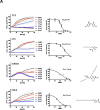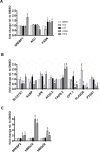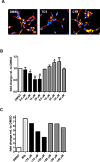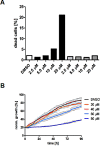The fatty acid synthase inhibitor triclosan: repurposing an anti-microbial agent for targeting prostate cancer
- PMID: 25313139
- PMCID: PMC4253440
- DOI: 10.18632/oncotarget.2433
The fatty acid synthase inhibitor triclosan: repurposing an anti-microbial agent for targeting prostate cancer
Abstract
Inhibition of FASN has emerged as a promising therapeutic target in cancer, and numerous inhibitors have been investigated. However, severe pharmacological limitations have challenged their clinical testing. The synthetic FASN inhibitor triclosan, which was initially developed as a topical antibacterial agent, is merely affected by these pharmacological limitations. Yet, little is known about its mechanism in inhibiting the growth of cancer cells. Here we compared the cellular and molecular effects of triclosan in a panel of eight malignant and non-malignant prostate cell lines to the well-known FASN inhibitors C75 and orlistat, which target different partial catalytic activities of FASN. Triclosan displayed a superior cytotoxic profile with a several-fold lower IC50 than C75 or orlistat. Structure-function analysis revealed that alcohol functionality of the parent phenol is critical for inhibitory action. Rescue experiments confirmed that end product starvation was a major cause of cytotoxicity. Importantly, triclosan, C75 and orlistat induced distinct changes to morphology, cell cycle, lipid content and the expression of key enzymes of lipid metabolism, demonstrating that inhibition of different partial catalytic activities of FASN activates different metabolic pathways. These finding combined with its well-documented pharmacological safety profile make triclosan a promising drug candidate for the treatment of prostate cancer.
Conflict of interest statement
The authors declare no conflicts of interest.
Figures












Similar articles
-
Overexpression of fatty acid synthase in human gliomas correlates with the WHO tumor grade and inhibition with Orlistat reduces cell viability and triggers apoptosis.J Neurooncol. 2014 Jun;118(2):277-287. doi: 10.1007/s11060-014-1452-z. Epub 2014 May 1. J Neurooncol. 2014. PMID: 24789255
-
Therapeutic and toxicologic evaluation of anti-lipogenic agents in cancer cells compared with non-neoplastic cells.Basic Clin Pharmacol Toxicol. 2012 Jun;110(6):494-503. doi: 10.1111/j.1742-7843.2011.00844.x. Epub 2012 Jan 16. Basic Clin Pharmacol Toxicol. 2012. PMID: 22151915
-
Fatty Acid Inhibition Sensitizes Androgen-Dependent and -Independent Prostate Cancer to Radiotherapy via FASN/NF-κB Pathway.Sci Rep. 2019 Sep 16;9(1):13284. doi: 10.1038/s41598-019-49486-2. Sci Rep. 2019. PMID: 31527721 Free PMC article.
-
Orlistat as a FASN inhibitor and multitargeted agent for cancer therapy.Expert Opin Investig Drugs. 2018 May;27(5):475-489. doi: 10.1080/13543784.2018.1471132. Epub 2018 May 10. Expert Opin Investig Drugs. 2018. PMID: 29723075 Review.
-
Pharmacological inhibitors of Fatty Acid Synthase (FASN)--catalyzed endogenous fatty acid biogenesis: a new family of anti-cancer agents?Curr Pharm Biotechnol. 2006 Dec;7(6):483-93. doi: 10.2174/138920106779116928. Curr Pharm Biotechnol. 2006. PMID: 17168665 Review.
Cited by
-
Peroxisome proliferator-activated receptor gamma controls prostate cancer cell growth through AR-dependent and independent mechanisms.Prostate. 2020 Feb;80(2):162-172. doi: 10.1002/pros.23928. Epub 2019 Nov 26. Prostate. 2020. PMID: 31769890 Free PMC article.
-
Triclosan targeting of gut microbiome ameliorates hepatic steatosis in high fat diet-fed mice.J Antibiot (Tokyo). 2022 Jun;75(6):341-353. doi: 10.1038/s41429-022-00522-w. Epub 2022 Apr 19. J Antibiot (Tokyo). 2022. PMID: 35440769
-
A novel approach to the discovery of anti-tumor pharmaceuticals: searching for activators of liponecrosis.Oncotarget. 2016 Feb 2;7(5):5204-25. doi: 10.18632/oncotarget.6440. Oncotarget. 2016. PMID: 26636650 Free PMC article. Review.
-
NF-κB pathway play a role in SCD1 deficiency-induced ceramide de novo synthesis.Cancer Biol Ther. 2021 Feb 1;22(2):164-174. doi: 10.1080/15384047.2021.1883414. Epub 2021 Feb 22. Cancer Biol Ther. 2021. PMID: 33612070 Free PMC article.
-
Lipid quantification by Raman microspectroscopy as a potential biomarker in prostate cancer.Cancer Lett. 2017 Jul 1;397:52-60. doi: 10.1016/j.canlet.2017.03.025. Epub 2017 Mar 23. Cancer Lett. 2017. PMID: 28342983 Free PMC article.
References
-
- Wakil SJ. Fatty acid synthase, a proficient multifunctional enzyme. Biochemistry. 1989;28(11):4523–4530. - PubMed
-
- Smith S, Witkowski A, Joshi AK. Structural and functional organization of the animal fatty acid synthase. Prog Lipid Res. 2003;42(4):289–317. - PubMed
-
- Brusselmans K, Swinnen J. The Lipogenic Switch in Cancer. Mitochondria and Cancer: Springer New York) 2009:39–59.
-
- Lupu R, Menendez JA. Pharmacological inhibitors of Fatty Acid Synthase (FASN)--catalyzed endogenous fatty acid biogenesis: a new family of anti-cancer agents? Curr Pharm Biotechnol. 2006;7(6):483–493. - PubMed
Publication types
MeSH terms
Substances
LinkOut - more resources
Full Text Sources
Other Literature Sources
Medical
Miscellaneous

